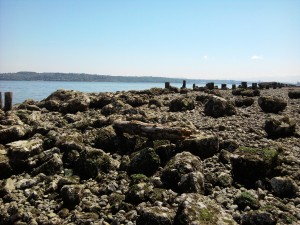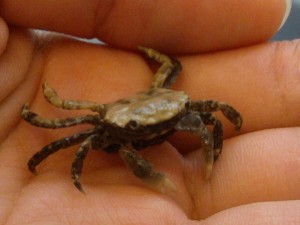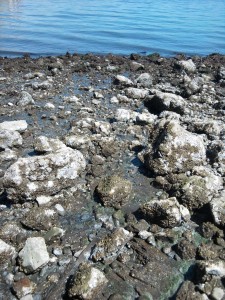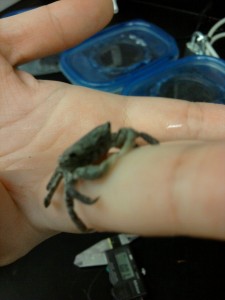Aloha!
Well, that sounds cheesy. Let’s start over.
Hi! I’m Corrie Wong. This summer, I’m fortunate enough to be working with Professor Joel Elliott studying intertidal crabs found at marine anthropogenic sulfide seeps along Ruston Way in Tacoma. If you aren’t familiar with the area, allow me to give you a brief background.
This strip of shoreline was once home to many lumber mills in the late 1800s to early 1900s. When those closed up and were destroyed, the leftover sawdust was dumped into the Puget Sound. The decomposition of the sawdust by bacteria releases a chemical called hydrogen sulfide which is extremely toxic to most organisms. Yet, animals can be found living in these toxic environments. Most common are green shore crabs, Hemigrapsus oregonensis, which will be referred to as oregonensis.
So what am I looking for exactly? I’m measuring the abundance, size, etc. of the crabs found in these seeps to crabs found outside the seeps. I’m also measuring the sulfide concentration of the water where the crabs are found.There are also other species of crabs that are sometimes found in the seeps such as Hemigrapsus nudus (which I’ll refer to as nudus), Cancer crabs (i.e. red rock crabs), and a black-clawed crab whose name escapes me at the moment. I do know, however, that those last two species will pinch you. Hard.
This week is a good low tide week, so most of the intertidal area is exposed during low tide. Fortunately for us, low tide is during the middle of the day rather than the middle of the night like it is in November. Unfortunately for intertidal life, they’re exposed at the hottest part of the day. As a group (Joel’s lab consists of 5 students this summer) we went to the sulfide seep and lucky for us IT WASN’T RAINING. I can even wear shorts! Anyway, when we first got there I was definitely surprised. It was as if there was an invisible semi-permeable barrier surrounding the actual seep where the water was flowing. In the barrier, the rotten egg smell is really strong. Take two steps back though, and I couldn’t smell it at all.
Being a marine life lover, I love spending time near the ocean. I could spend hours poking around tide pools. There is nothing better than the smell of salt water in the air and the sound of waves lapping at the shore. It reminds me so much of where I grew up (if you didn’t guess from my cheesy greeting, I’m from Hawaii). This research project allows me to do what I love and I couldn’t be more grateful for the opportunity.
If you’re wondering if I’ll be measuring crabs the whole summer, I won’t be. I also plan to do some experiments in the lab that involve the crabs’ toleration to sulfide and habitat preferences. More on that later as the summer progresses. For now, enjoy the adorableness of Priscilla and Henry. Did I mention that I name some of the crabs I collect?




